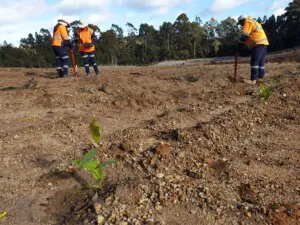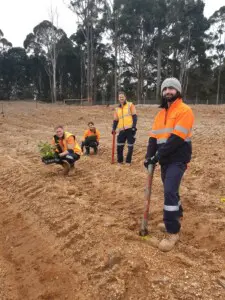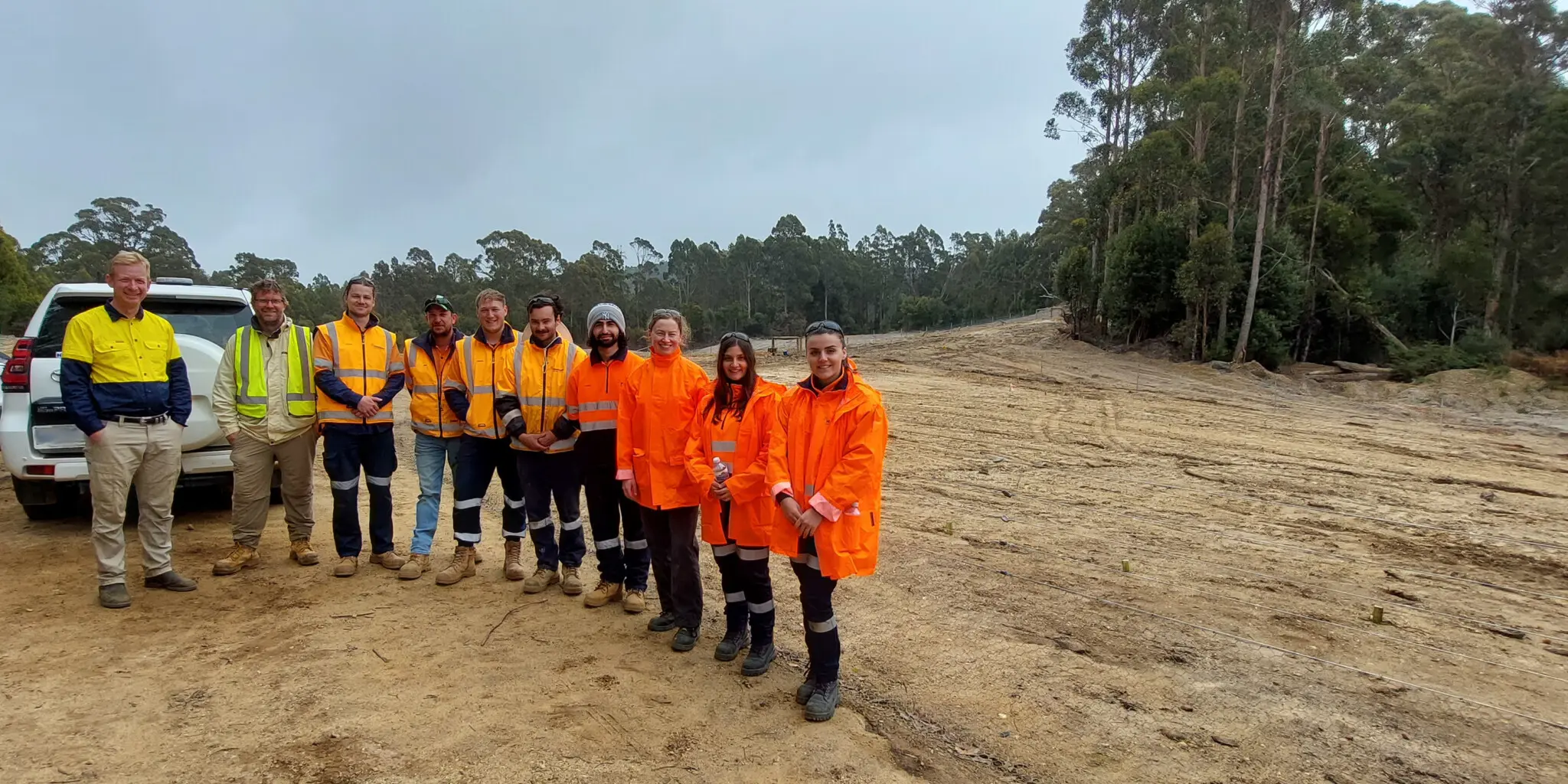
Planting out seedlings. Photo: Rebecca Jordan (Oct 2023).
But it’s a crucial part of a new experimental revegetation site in Tasmania, one of five such plantings across Australia. They’re being established as part of a CRC TiME project examining the effectiveness of alternative, climate-adapted seed-sourcing strategies for revegetation. The goal is to see what works when it comes to revegetation and mine closure in a changing climate (CRC TiME Project 4.6). This project brings together research, industry and mining companies, technology and service suppliers (METS) to create and monitor a network of experimental plantings across Australia over three years (2022-2025).
At the Tasmanian site, CSIRO is working with Hanson Australia to establish an experimental revegetation planting in one of their rehabilitation areas. What began as a logistical challenge of how to efficiently plant over 2000 seedlings became a great engagement opportunity. Hanson organised their Southern Region graduate management trainees to come to Tasmania and assist the teams from CSIRO and Hanson with fieldwork. This not only helped get the seedlings planted out faster, but it also allowed more Hanson staff to be involved in the project. Graduate management trainees, in turn, gained experience and insight into the rehabilitation aspects of Hanson’s business.
Over three days in early October 2023, a fantastic effort from the CSIRO and Hanson teams saw 2312 seedlings planted out and their initial heights measured. Soil samples were also taken to investigate the soil microbiome over time, as the plantings grow.
The seedlings planted were a mix of Eucalyptus obliqua (messmate stringybark), Leptospermum scoparium (manuka), and Acacia melanoxylon (blackwood) – all species native to the area. Given the small size of the seedlings, it was hard to see all the work put in when looking across the site. Thankfully, the taller eucalypt seedlings happily swayed in the breeze, making visible from a distance what we’d achieved!
 Planted site with eucalypt seedlings. Photo: Rebecca Jordan (Oct 2023) |
 Planting out seedlings. Photo: Rebecca Jordan (Oct 2023). |
During the week, I gave a lunchtime talk to give the Hanson graduate team some context and background to this project. We discussed the importance of restoring landscapes for both biodiversity and our health and wellbeing. We also spoke about the challenges of revegetation under climate change, and how alternative seed sourcing strategies, like those being tested in this project, aim to make revegetation plantings more resilient. Sarah Bellman (Hanson Operations Manager Country) also visited during the week, giving us an opportunity to share our work, and where it fits in with the larger CRC TiME project.
This was a great demonstration of what effective partnerships can achieve. This collaboration created exciting opportunities to learn and share knowledge across our teams as we dug into the next phase of this project.
 A big thank-you to the whole field team (left to right in photo): Shaun Brooks (CSIRO), Bruce Murray (CSIRO), Jacob Szabo (Hanson), Michael Forrest (Hanson), Fergus Gregori (Hanson), Travis Earle (Hanson), Rohat Erdogan (Hanson), Rebecca Jordan (CSIRO), Emily Grekos (Hanson), Dori Pali (Hanson). Also, a big thanks the wider CRC TiME Project 4.6 team for contributions to all the preparation work toward establishing this Tasmanian site, including Suzanne Prober and Shaun Brooks (CSIRO), Martin Breed and Jake Robinson (Flinders University), Rachel Standish (Murdoch University), Siegy Krauss, Margaret Byrne and Rachel Binks (DBCA), and Vern Newton, Brendan Liveris, Andrew Proud, Michael Forrest and Jeff Burns (Hanson). (Photo: Sarah Bellman, Oct 2023).
A big thank-you to the whole field team (left to right in photo): Shaun Brooks (CSIRO), Bruce Murray (CSIRO), Jacob Szabo (Hanson), Michael Forrest (Hanson), Fergus Gregori (Hanson), Travis Earle (Hanson), Rohat Erdogan (Hanson), Rebecca Jordan (CSIRO), Emily Grekos (Hanson), Dori Pali (Hanson). Also, a big thanks the wider CRC TiME Project 4.6 team for contributions to all the preparation work toward establishing this Tasmanian site, including Suzanne Prober and Shaun Brooks (CSIRO), Martin Breed and Jake Robinson (Flinders University), Rachel Standish (Murdoch University), Siegy Krauss, Margaret Byrne and Rachel Binks (DBCA), and Vern Newton, Brendan Liveris, Andrew Proud, Michael Forrest and Jeff Burns (Hanson). (Photo: Sarah Bellman, Oct 2023).
By Dr Rebecca Jordan
